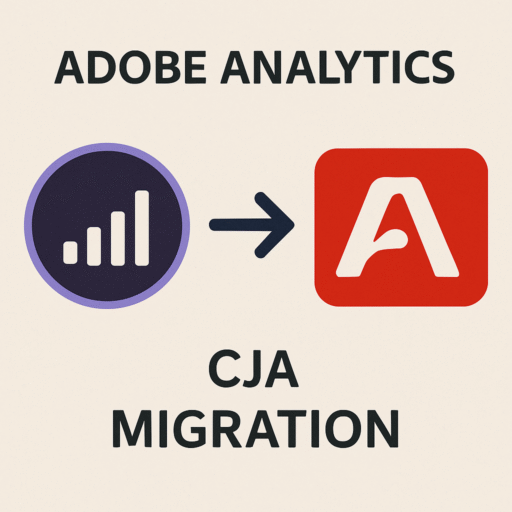As Adobe Analytics users begin embracing the broader capabilities of Customer Journey Analytics (CJA), one question consistently arises: How do we migrate our existing components? After all, many teams have invested years building reliable segments, calculated metrics, and dashboards in Adobe Analytics (AA). Rebuilding everything from scratch is not a viable option—nor should it be.
In this post, we’ll explore how to approach component migration thoughtfully, highlight key differences between AA and CJA, and provide actionable steps for making the transition as smooth as possible.
Why Move from AA to CJA?
Adobe Analytics has long been a powerhouse for web and mobile behavior tracking. But in today’s world of omnichannel engagement, it’s increasingly important to have a 360-degree view of the customer journey—across online and offline touchpoints.
This is where Customer Journey Analytics shines. Built on top of the Adobe Experience Platform (AEP), CJA allows you to analyze data from multiple sources—web, mobile apps, CRM systems, call centers, POS systems, and more—using a flexible, scalable data model (XDM). Combined with real-time streaming, advanced identity resolution, and person-based analysis, CJA enables use cases that were either difficult or impossible in AA.
However, CJA is not a plug-and-play extension of AA. It requires a shift in mindset, and yes, some component rebuilding.
What Are Components in AA and CJA?
In Adobe Analytics, components typically refer to:
- Segments (visitor, visit, and hit-level)
- Calculated Metrics
- Workspace Projects
- Dimensions and Metrics (props, eVars, events)
In CJA, the same building blocks exist, but they behave differently:
- Segments are time-aware and person-centric
- Calculated metrics are schema-driven and support advanced logic
- Workspace Projects are more flexible and cross-channel by default
- Dimensions and Metrics are derived from the underlying schema (XDM) and tied to specific data views
So while the terminology is similar, the foundations are quite different.
Key Differences That Impact Migration
| Feature | Adobe Analytics | Customer Journey Analytics |
|---|---|---|
| Segmentation Levels | Hit, Visit, Visitor | Event, Session, Person (with time-aware rules) |
| Data Source | Web SDK/AppMeasurement | Adobe Experience Platform Datasets |
| Identity | Visitor ID / ECID | Any identity in identity graph (email, CRM ID, ECID, etc.) |
| Data Model | Proprietary | XDM (Experience Data Model) |
| Metrics Logic | Event-based, no lookback | Fully flexible, including time and identity conditions |
| Breakdown Limits | Limited | Unlimited nested breakdowns |
Understanding these differences is critical before attempting to recreate components.
Step-by-Step Guide: Migrating Components
1. Audit Your AA Components
Start by exporting your key AA components:
- Use the Component Admin or Adobe Analytics API to extract a list of all segments, calculated metrics, and projects.
- Prioritize based on usage, business impact, and whether they’re still relevant.
🎯 Tip: Focus on segments and metrics actively used in dashboards or tied to KPIs.
2. Design Your CJA Data Views
Data Views in CJA are equivalent to report suites in AA—but more flexible. You define:
- Dimensions and metrics to expose
- Time zone and session settings
- Identity stitching preferences
- Component filters like event or dataset-level filters
Ensure the data you’re bringing in from AEP is clean, mapped properly, and includes identity data if you want person-based views.
3. Recreate Segments Thoughtfully
AA segments can’t be imported directly. But most logic can be replicated—and improved—within CJA:
- Use “Include Before/After Sequence”, Lookback Windows, and Stitching across channels.
- Consider breaking out complex AA segments into modular components that are easier to reuse.
Example: Instead of a visitor segment that includes both a paid search visit and a form submission, split them and use combinations for more flexibility.
4. Rebuild Calculated Metrics
CJA’s Calculated Metrics Builder supports:
- Mathematical functions (sum, avg, ratio, etc.)
- Conditional logic (IF statements)
- Custom time ranges
- Filters on events, sessions, or persons
Use this opportunity to streamline or enhance metrics with CJA’s more granular control. Also, avoid overloading data views with every possible metric—build only what’s needed.
5. Rebuild Dashboards in CJA Workspace
CJA’s Workspace environment is similar to AA but with improved flexibility:
- Unlimited breakdowns (no nesting limits)
- Cross-dataset analysis
- Real-time filters
- Identity-based comparisons (e.g., email vs ECID)
Use Workspace templates to recreate core dashboards, then layer on enhancements like visualizations, calculated metrics, and filters.
Validation: Don’t Skip This Step
After rebuilding components, run parallel reports in AA and CJA for overlapping time periods. Expect small discrepancies due to:
- Identity resolution differences
- Schema transformations
- Session timeout configurations
But major differences should be investigated and resolved before production rollout.
Common Migration Pitfalls
- ❌ Migrating everything blindly – Focus on what’s valuable.
- ❌ Ignoring identity resolution – You can’t do person-based analysis without it.
- ❌ Overcomplicating early – Start with clean, simple data views and iterate.
- ❌ Skipping documentation – Keep track of what’s migrated, changed, and improved.
Final Thoughts
Migrating from Adobe Analytics to Customer Journey Analytics isn’t a copy-paste job—it’s a re-architecture opportunity. It’s your chance to unify fragmented data, elevate insights, and future-proof your analytics stack.
Approach the migration as a phased process:
- Audit > Prioritize > Rebuild > Validate > Educate
And remember, this is a strategic shift, not just a technical one.
Need help with your CJA setup or component strategy?
Stay tuned for more tutorials, deep dives, and templates—or get in touch if you’re tackling a specific migration use case.
